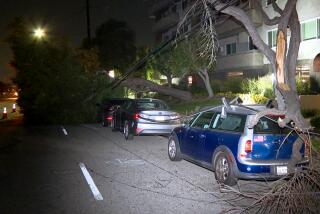Arctic Winds Whip Up Ash, Grass Seed
- Share via
Gale-force winds from the fringes of an arctic storm lashed Southern California before dawn Monday, uprooting trees, bringing down power lines and whipping up grimy blizzards of ash, dust--and probably newly sewn grass seed--in areas ravaged by the recent brush fires.
“It looked as though the fire was burning again, the way the ashes were blowing all over the place,” said Jack Martin, 62, who lives in a home spared when flames devastated his Altadena neighborhood three weeks ago.
“It was like it was snowing,” he said, “only this time, the snow was brown.”
Officials said the scouring winds may have dealt a serious blow to reseeding efforts undertaken last week in an effort to reduce mudslides and erosion this winter when expected downpours fall on fire-denuded slopes.
“Those winds were our worst-case scenario, other than a really heavy rain,” said Clyde Sims, an assistant chief with the Los Angeles County Fire Department’s Forestry Division.
“When I drove up the 210 Freeway, I saw a lot of dust and ash in the air, and I presume some of the seed was in the air too,” Sims said. “That certainly wasn’t what we had wanted.”
Sims said that even though last week’s relatively gentle rains may have caused some seeds to germinate, it is still too early for the sprouting plants to take root firmly.
The extent of the wind damage to seeding in the fire areas will not be known until a field inspection is completed this week, Sims said. He said that although there is still time to reseed again, “that’s a question mark because of the money involved.”
The ashen cloud from the Altadena burn area spread southwest over Pasadena like a pall of gritty smog late Sunday and early Monday, depositing a layer of gray-brown dust throughout the city.
“The swimming pool here looks like it’s filled with chocolate milk,” said Roger Babin, a gardener cleaning up a yard at a home on Villa Heights Road.
The winds--which gusted as high as 53 m.p.h. in the Santa Monica Mountains--churned up waterspouts off Oceanside, Del Mar and Camp Pendleton on Monday morning.
High winds uprooted a tree that demolished a car in Corona del Mar, and extensive tree damage was reported in foothill communities at the base of the San Gabriel and San Bernardino mountains.
At least 21,000 customers of the Department of Water and Power lost their electricity late Sunday and early Monday when lines were downed by the winds. In most cases, service was restored by midafternoon Monday.
Downed lines sparked a blaze that blackened five acres of brush near Sun Valley. Embers from the Calabasas/Malibu fire were fanned to life by the winds, and several small thickets of brush burned before the blazes were brought under control by firefighters.
Curtis Brack, a meteorologist with WeatherData Inc., said the winds were generated by a cold, upper-level storm system that swept south along the eastern slope of the Sierra, bypassing the Los Angeles Basin and much of coastal Southern California.
Snow dusted the peaks of the San Gabriel and San Bernardino mountains and the Cleveland National Forest. Brief but heavy thundershowers were reported in the foothills of eastern San Diego County.
As the storm system headed east into Arizona on Monday afternoon, the winds here began to diminish, all but ending in most areas of Southern California by nightfall.
Brack said skies should be mostly sunny today and Wednesday in the Los Angeles area, with little wind and high temperatures ranging from the mid-60s to the mid-70s. The high temperature at the Los Angeles Civic Center on Monday was 73 degrees, after an overnight low of 53.
A low-pressure system moving slowly down the coast will bring a chance of a little rain Thursday, Brack said. He said skies should clear again Friday, with more gusty winds possible by the weekend.
Although the rain predicted Thursday should not pose much of a threat, fire officials are concerned about longer-range forecasts.
Meteorologists said a resurgence of the El Nino weather phenomenon means Southern California and northern Mexico could experience more of the heavy rains and resultant mudslides that destroyed homes, buried highways and killed more than a dozen people last winter.
Fire officials say downpours this winter--falling on burned slopes stripped of the vegetation needed to hold soil in place--could wreak even worse devastation.
More to Read
Sign up for Essential California
The most important California stories and recommendations in your inbox every morning.
You may occasionally receive promotional content from the Los Angeles Times.










